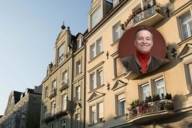
Alexander Kardaschenko is the founder of yourmunichtour.de, an official guide of the City of Munich and a Schwabing resident himself. He has been guiding guests through the cult district for many years. He believes that the same is true today as it was in the past: Schwabing is special!
“Scandal-ridden Countess Franziska von Reventlow said well over a hundred years ago that Schwabing is not a place, but a condition, when she described a district where many people like her belonged to the bohemian class. This movement of artists and intellectuals established the myth of Schwabing in the middle of the German Empire through their opposition to everything bourgeois, which became synonymous with a liberal attitude to life.
Schwabing was the epitome of the Munich nightlife of the post-war years, the student movement, the awakening and the ‘68 generation. Of course, the neighbourhood has changed, but if you go looking for evidence of it here, you can still sense the myth of years gone by.“
Schwabing is probably Munich's most famous district. This is due on the one hand to the district's eventful history, and on the other to its sights – such as Leopoldstrasse, the Siegestor (gate) and the Englischer Garten, which at 375 hectares is one of the largest inner-city parks in the world. From the Monopteros, you have a great view of Munich's city centre, you can watch the surfers at the Eisbachwelle and take a break with a snack and a beer in the beer garden at the Chinesischer Turm.
Some of the major and most revolutionary clubs in the world were once located in Schwabing – famous guests such as the Rolling Stones, Pink Floyd and Jimi Hendrix turned night into day in Leopoldstrasse. Today you'll find award-winning bars like Call Soul, long-established cafés like Münchner Freiheit and Schwabing favourites like Milchhäusl, a small organic kiosk in the middle of the English Garden.
Small cinemas, lots of fringe theatre and good cabaret – Schwabing is still famous for this today. Since its relocation, the Heppel & Ettlich (private theatre) has focused primarily on live music and the Vereinsheim is not only a meeting place for football fans, but also hosts pub quizzes, concerts and readings. And then there are the small cinemas: The Monopol screens selected independent films but also serves drinks at the in-house bar.
In recent years, Hohenzollernstrasse has increasingly become Kaufingerstrasse's little sister. International chains open their branches here, but in between there are real Munich originals – like the Kunst Oase, in which Schwabing architect and artist Manfred Wambsganss sells antique furniture and lamps. One street further, you find Kunst und Spiel, a sustainable children's shop that has been going strong for half a century already. And at Lehmkuhl, the people of the quarter have found their favourite books for over 110 years.
Quirky bars and legendary little pubs called Boazn can be found all over Munich, but in Schwabing the density is particularly high. There is the legendary Schwabinger 7, also called "Schwasi" by the locals, where people have been drinking and chatting since the 1950s, with a short interruption due to relocation. In the "Pils Doktor" schnapps is served with a model train and at "Bei Otto", guests can choose a song from the jukebox with a 2-DM (German Mark) coin.